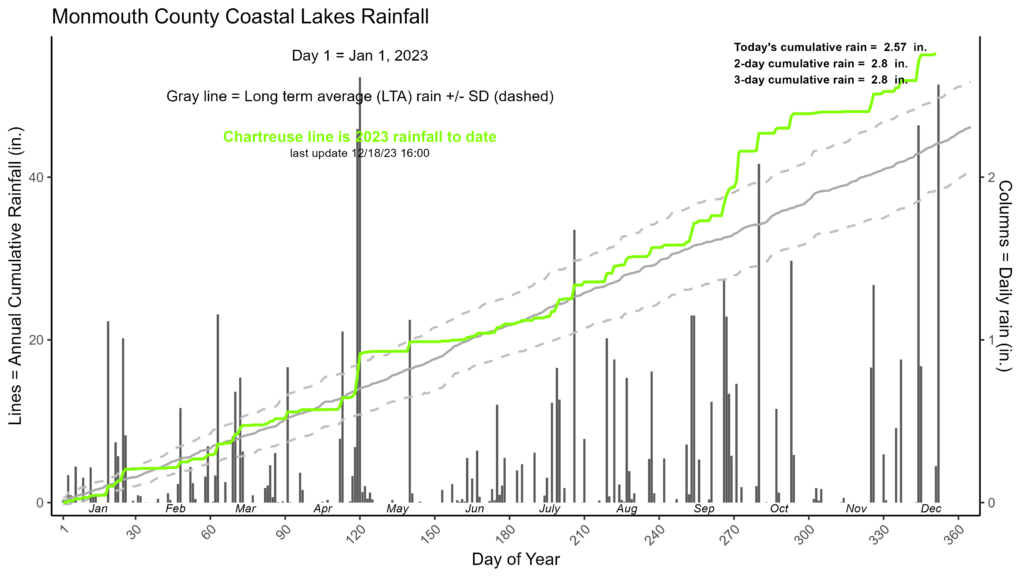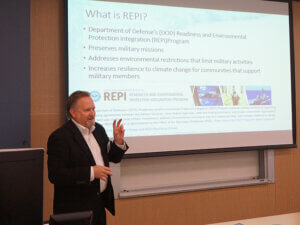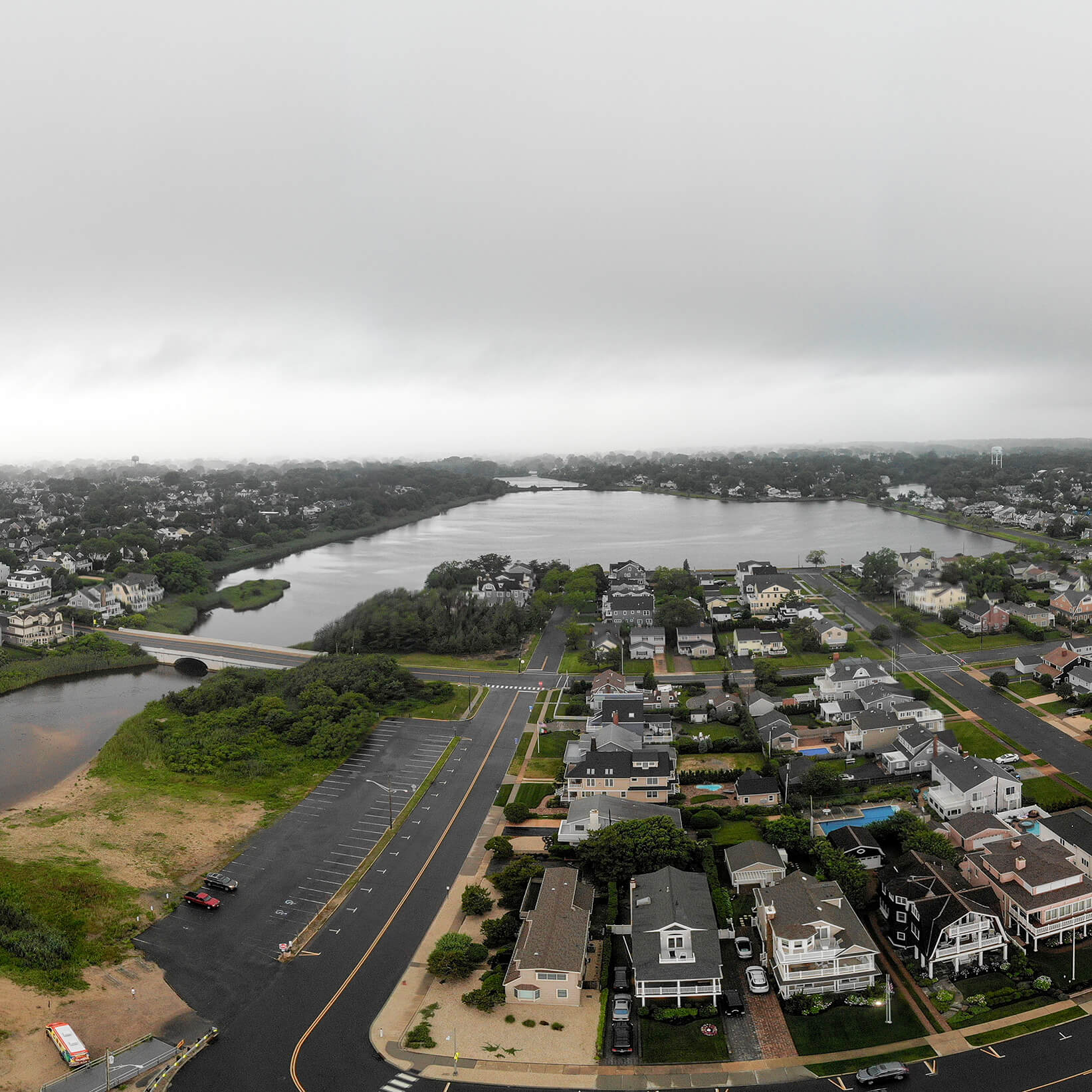Monmouth University hosted its fifth annual Coastal Lakes Fall Summit on Dec. 12 to reflect on the state of a dozen local water bodies and explore strategies for improving them. A prominent theme in this year’s discussions was the recurring problem of lake flooding and steps that communities can take to make them more resilient.

The event gathered dozens of volunteer members of the Coastal Lakes Observing Network (CLONet), a partnership of Monmouth University scientists and students and community volunteers dedicated to monitoring water conditions at Deal Lake, Fletcher Lake, Jackson Woods Pond, Lake Como, Lake Takanassee, Shadow Lake, Silver Lake, Spring Lake, Sunset Lake, Sylvan Lake, Wesley Lake and Wreck Pond. Through CLONet, community members regularly sample their local lakes for temperature, salinity, clarity, dissolved oxygen, and phycocyanin levels (an important indicator of harmful algal blooms) and file their readings to an online database for analysis. Monmouth University Phytoplankton and Harmful Algal Bloom Lab (PHAB Lab) researchers sample the lakes for the same parameters plus measures of nutrient levels and the biomass and genetic makeup of phytoplankton populations in the waters.
Since 2019, the community scientists have recorded over 1,700 samples to pair with the PHAB Lab’s. The wealth of data presents a clear picture of what normal conditions look like in the lakes, so when harmful algal blooms and other sudden changes occur, they can be spotted easily and investigated. Much of this data is available for public viewing on the CLONet Data Explorer web app.

One clear anomaly visible on the Data Explorer for 2023 is the level of rainfall in the lake areas, which is currently well outside the normal range of variability. As the graph above shows, the year started relatively dry until a powerful three-day storm that brought 6 inches of rain in late April. Then on Sept. 29, the remnants of Hurricane Ophelia dumped over 7 inches in a matter of hours, causing severe flooding in several of the lakes. Wesley Lake CLONet member Doug McQueen noted that some businesses in Asbury Park were still closed due to the damages, including a music venue that was forced to permanently shutter.

“Many of these lakes have been used historically as stormwater retention basins,” Urban Coast Institute Associate Director Tom Herrington said. “The more intense coastal storms and increased flooding we’ve been experiencing have shown how climate change will impact them worse in the future.”
School of Science Assistant Dean John Tiedemann said that much of the infrastructure meant to control water and runoff in the lakes is old and inadequate, in many cases predating the institution of impervious coverage regulations. In a presentation on green infrastructure solutions he helped design for Sylvan Lake, Herrington showed images of crumbling bulkheads and areas where so much soil runoff had been deposited from the sewer system that it had piled above water level. With funding through the Department of Defense, the area will be dredged and the silt will be placed around the lake’s perimeter, helping provide some sites with a more natural slope to the water than the bulkheads, better filtering runoff, and serving as a habitat for birds and pollinators that will be attracted to plantings there.
Help could be on the way for the lakes by way of an influx of funding. Clean Waters Consulting, LLC Owner Stephen Souza delivered a presentation on how communities can best position themselves to acquire U.S. Environmental Protection Agency (EPA) 319 Grant Program funds, which aim to reduce nonpoint source pollution in waterways. The New Jersey Department of Environmental Protection is provided a block of this funding which it awards competitively for proposals that demonstrate they can make a measurable improvement and provide a local match.
Souza encouraged applicants to review successful past 319 proposals and online “success stories” synopses to get a sense of what elements do well and emulate them in their own proposals. He stressed that “2024 is our year,” because the NJDEP was planning to prioritize the Atlantic coastal region for grants.
Tiedemann explained how he and Souza had recommended a regional approach to coastal lake management in a 2009 report on the future of Monmouth County coastal lakes, but that idea never got to the point of implementation. Endowed Professor of Marine Science Jason Adolf said that communities with watershed protection plans in place receive greater consideration in the 319 application process and hold the advantage of having a list of improvement projects ready that could be candidates for funding. He raised the possibility of the CLONet lake communities banding together to create a regional plan, informed by their own data, that could strengthen their hands moving forward.
“If we have a regional protection plan that covers all of the coastal lakes, it will give each lake the leverage needed to apply for future rounds of funding that become available,” Adolf said. “The NJDEP likes the idea of a regional approach because it ends up being cost-saving, effective and efficient.”
Click here to view presentation slides from the event.

